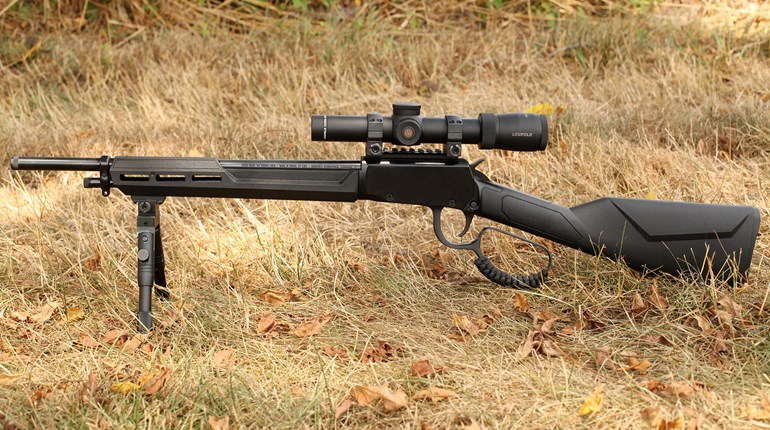
You don’t really need an ATV to hunt turkeys, but it sure makes it a lot easier. Actually, an agile side-by-side ATV with a roll cage for protection and a dump bed for chores makes just about everything easier around the house, farm or field. It also makes it a heck of a lot more fun. At least that’s what I found when I test-drove Yamaha’s Viking EPS over a large swath of western Oklahoma red dirt last spring.
After I took a giant Rio Grande turkey on the first morning of my hunt, I found myself riding around the 5,000-acre Croton Creek ranch simply for fun. In doing so I discovered that this modern-day side-by-side ATV is a great balance between practicality and sport. It’s not like a four-wheeler of old, where you must straddle the gas tank and toss your weight around on each turn to avoid getting tossed off. Nor is it like a John Deere Gator side-by-side that’s meant for puttering from one barn stall to the next. Nah, the Viking is a hybrid vehicle, meant for fun and work. More accurately it should be called a side-by-side-by-side, as it holds three passengers comfortably on the bench front seat. The fun is evident in its aggressive body lines and 11-inch ground-cleaning stance; the work part is a little more subtle. Mainly, it’s evident by the Viking’s 43x27 inch cargo bed.
As I'm more of a hunter than a thrill seeker, a bed or at least a cargo rack is an ATV-must for me, for without it the ATV is nothing but an expensive toy. The Viking’s 600-pound cargo capacity is more than enough for a pile of turkeys, a couple deer (with heads tied to the roll cage) and a veritable pallet of guns and ammo. Indeed, several afternoons I loaded down the Viking with a couple guns, ammo and targets before driving to a makeshift rifle range where I found another great use for an ATV: long-range shooting. While it might sound ridiculous at first, for long-range practice where I often shoot at 500 yards and further, walking to and from the target each time is not ideal. Sure, I can use the exercise, but walking long distances between shots is not conducive to good groups due to an increased heart rate. So, if I couldn’t find a bullet hole in the spotting scope, it took only moments to hop in the Viking, race down to the target to inspect or change it, then get back to shooting.
As I drove back and forth over rough rocks, careful not to jostle my scoped rifle that rode inside an optional Gun Scabbard bolted to the roll cage, I learned something else: I really didn’t have to ease around avoiding the rocks at all, thanks to the Viking’s independent double-wishbone suspension that boasts over 8 inches of vertical movement. I was absolutely amazed when I’d see a rock or bump in the road, prepare my body for it, then feel almost nothing as the Viking’s shocks ate it up like pudding, even at high speed. The Viking also steered smoothly and easily, not like the four-wheeler I rode a kid, but more like a car. That’s because the version I drove has Electronic Power Steering (EPS), and so turning the front wheel on this 1,400-pound machine was just like your car. The EPS version costs $1,000 extra, but I think it’s worth it.
Probably most important, even an inexperienced ATV pilot like me can drive the Viking safely even while traversing hairy trails. That’s because an encompassing steel rollcage, doors to keep legs and feet inside in case of a roll, and three-point seatbelts do more than make you simply feel safe. They actually work to keep you healthy in the event of a crash or rollover. Industry-best disk brakes on both front and rear wheels do their part to see that crashes are avoided in the first place.
Now, I’m not suggesting that a roll cage, seat belts and good brakes allow someone to drive like a maniac and not get hurt, but for parents who want one ATV for the family—one for chores around the house and to satisfy the kids’ incessant, fist-pumping chants of “ATV, ATV, ATV!” at Christmas time—the Viking side-by-side is a much safer ride than other types of ATVs when seatbelts and helmets are used properly.
Finally, there’s the Viking’s powertrain, and this is where Yamaha really excels. It features a 686cc, liquid-cooled, fuel-injected engine that, combined with Yamaha’s Ultramatic automatic transmission, delivers serious horsepower smoothly to all four tires when 4x4 mode is selected. In Low gear it’ll pull upwards of 1,500 pounds; in Hi it’ll go about as fast as any adult wants to go. How do I know it will go around 70 mph? During a straightaway, I glanced at the speedometer once through my white-knuckled grip on the steering wheel.
After leaving hunting camp, complete with a wild turkey to be placed in the freezer until Thanksgiving and a newfound respect for ATVs as tools for hunting and work, I realized that I wanted a Viking for myself. One Google search later, however, I learned their price—$11 to 14K—and I nearly spit my Sam’s Choice cola.
Why would I buy an ATV when I can nearly buy a new truck for that, I thought. But then reality hit me. Like it or not, a new Ford or Chevy 4x4 truck costs $40,000-$70,000 dollars these days. While my truck gets me to the field in style, I’m reluctant to drive it through the field. So after reminding myself of this, I now look at a side-by-side ATV as an investment to protect a larger investment. I can’t help it that the Viking is also so much darn fun.







































